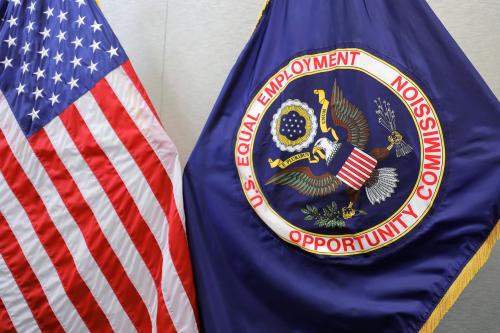Progressive Democrats have been advocating to end the Senate filibuster so Democrats can pass legislation by majority rule. They have been joined by many moderates who may have resisted this change in the past but now believe Republicans have so abused the rule that it has become an impediment to government function. Alice Rivlin, who passed away in May 2019, was in this category and will say so in her final book, “United we Fall; The Case for Consensus” written with Sheri Rivlin and Allan Rivlin, due for publication in 2021 by Brookings Institution Press. In this excerpt from Chapter 10 she sites Alexander Hamilton, James Madison, and several Brookings colleagues to argue the filibuster no longer serves any purpose.
The Senate should change the rules to eliminate the filibuster and restore the 51-vote simple majority as the threshold necessary to end debate on all legislation. A filibuster is an attempt to halt action in the Senate by “talking a Bill to death,” that is, keeping debate going– or offering endless motions and amendments– to block the Senate from voting. Like many others I used to believe the filibuster was part of the Founding Fathers’ design to make the Senate a more deliberative body than the House, but the filibuster was not part of their original plan.
The first Senate created by the Constitution was majority rule for all questions except five specific exceptions where a higher two-thirds threshold was set for votes to: 1) expel a Senator; 2) ratify a treaty; 3) override a presidential veto; 4) convict a president, justice, or cabinet official on impeachment; and 5) propose constitutional amendments.
The principal authors of the Constitution, James Madison and Alexander Hamilton, believed strongly that a simple majority should decide most issues in the Senate; both had shared the frustrating experience of the Second Continental Congress that laboriously drafted the Articles of Confederation they replaced with their new Constitution. They did not want to repeat the mistake of supermajority requirements that slowed progress. The Senate they were designing would be deliberative, but also functional, and based on majority rule.
Madison argued against a supermajority in Federalist 58, saying if there were such a requirement, “the fundamental principle of free government would be reversed. It would be no longer the majority that would rule: the power would be transferred to the minority.”
Hamilton issued a similar warning in Federalist 22, “If a pertinacious minority can control the opinion of a majority,” the result would be “tedious delays, continual negotiation,” and “contemptible compromises of the public good.” And when accommodation cannot be reached, Hamilton predicted, “the measures of government must be injuriously suspended, or fatally defeated,” and “kept in a state of inaction” and “weakness” bordering on “anarchy.”
Sadly, this prediction now seems to be reaching fruition. The Senate was supposed to be the more deliberative body, but the filibuster was not designed to enhance deliberation, nor to raise the threshold for action in the Senate to a 60-vote supermajority. It was not designed to force bipartisan cooperation to get anything done. In fact, it was not designed at all. It arose totally by accident.
My Brookings colleague Sarah Binder wrote a book about the filibuster with Steven Smith, and as she told the story in very accessible 2010 Senate Committee testimony, the filibuster was an unintended consequence of an 1806 Senate rules reform advised by Vice President Aaron Burr (shortly after the deadly duel with Alexander Hamilton). Burr insisted the Senate rulebook was too long and complicated. In the simplification, the Senators inadvertently eliminated the rule to “call the previous question”–in other words, get back to the business at hand. Although the rule had not yet been used this way in either chamber, the House soon learned to use the previous question rule to cut off debate. It would be decades before the Senators realized in 1837 that having eliminated their chamber’s previous question motion, any minority of Senators could block votes, and the filibuster was born.
Over the next four-score years the filibuster was used with increasing frequency and obstructiveness until 1917. With the Senate debating America’s involvement in the first World War, President Woodrow Wilson pushed adoption of a new rule allowing two-thirds of Senators to cut off debate by invoking “cloture” and for the first time the Senate was governed by super-majorities.
For the next half century filibusters were reserved for rare times when a minority of Senators believed the majority was making a grave mistake, often on the wrong side of history. Senator Strom Thurmond (D-NC) famously set the filibuster record, holding the floor for 24 hours against the Civil Rights Act of 1957. Seven years later Thurmond was part of a solid block of Southern Democrats stopping most Senate action for two months in an ultimately doomed effort to block the Civil Rights Act of 1964. But through the end of the 1970, there was no two-year span of a Congress where as many as ten cloture motions were filed in the Senate.
There were 24 Senate cloture motions filed in the 92nd Congress (1971-1972), an average of one per month. This would rise to three per month through the end of the Clinton Presidency. Routine use of filibusters started in this millennium. Both sides pressed each other and the Senate rules to gain as much advantage as they could, but when Mitch McConnell’s Republicans filibustered 252 Democratic bills and nominations backed by Harry Reid and President Barack Obama (an average of 11 per month) in the 113th Congress (2013-2014), it was undeniable that the parliamentary tactic was being abused. It was not the rule that had changed, it was the norms as to how the rule was being used. For more than a decade now, the filibuster has become in practice something it was never intended to be, and it has not been through most of American history: a de facto threshold of a 60-vote supermajority needed to pass legislation through the Senate.
The majority party writes the rules for the Senate (if they have enough votes to pass them) and majorities have created many pathways for passage of laws, nominations and other Senate business that were exempt from potential filibusters over the years. Another Brookings colleague, Molly Reynolds, wrote a book examining the at least 161 times the Senate has written “Exceptions to the Rule” in the 45 years from 1969 to 2014. These include majority up-or-down votes on Congressional Budgets and Reconciliation Bills and “fast-track” processes for some trade bills and military base closings. More recently, and quite contentiously, Senate Democrats eliminated the filibuster for presidential executive appointments, and lower-level court nominations in 2013. Senate Republicans eliminated the filibuster for Supreme Court nominations in 2017.
On its face it looks like the problem with the filibuster is that it encourages too much debate, but as it is being used today, the problem is that it forestalls debate. When the debate cannot be ended, the debate never starts.
Even if it was not part of the original design, there was a time it could be argued that, in practice, the filibuster encouraged bipartisan cooperation. Laws could be modified to avoid engendering enough opposition to sustain a filibuster from the other party. But when the filibuster becomes nearly universally employed to raise the threshold for every bill to a 60-vote supermajority, the net effect is to diminish bipartisan cooperation. As it is used today the filibuster is a weapon of hyper-partisan warfare, not a tool to end it. Recent years have brought ever more frequent filibusters but no peace in the partisan battles.
There are some partial measures Democrats could take the next time they control the Senate, such as limiting the number of filibusters that can be mounted, further restricting the types of motions or measures that can be filibustered, or returning to the practice of “talking filibusters,” requiring Senators to hold the floor and talk as they did before the 1970s. These half measures would be an improvement, especially as part of bipartisan negotiations that helped reduce partisan polarization and increase cooperation on legislation. But we should not kid ourselves, the next step toward weakening the filibuster will either be the last stop, or the next to the last stop, toward elimination. The filibuster benefits the minority, and the majority makes the rules. Both parties weakened the filibuster the last time they took control of the Senate and both must assume the other party will end it the next time they take power.
The Brookings Institution is committed to quality, independence, and impact.
We are supported by a diverse array of funders. In line with our values and policies, each Brookings publication represents the sole views of its author(s).







Commentary
One more moderate voice for Filibuster Elimination, Alice Rivlin
April 12, 2021